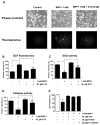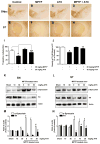Astaxanthin protects against MPTP/MPP+-induced mitochondrial dysfunction and ROS production in vivo and in vitro
- PMID: 21056612
- PMCID: PMC3010303
- DOI: 10.1016/j.fct.2010.10.029
Astaxanthin protects against MPTP/MPP+-induced mitochondrial dysfunction and ROS production in vivo and in vitro
Abstract
Astaxanthin (AST) is a powerful antioxidant that occurs naturally in a wide variety of living organisms. We have investigated the role of AST in preventing 1-methyl-4-phenyl-1,2,3,6-tetrahydropyridine (MPTP)-induced apoptosis of the substantia nigra (SN) neurons in the mouse model of Parkinson's disease (PD) and 1-methyl-4-phenylpyridinium (MPP+)-induced cytotoxicity of SH-SY5Y human neuroblastoma cells. In in vitro study, AST inhibits MPP+-induced production of intracellular reactive oxygen species (ROS) and cytotoxicity in SH-SY5Y human neuroblastoma cells. Preincubation of AST (50 μM) significantly attenuates MPP+-induced oxidative damage. Furthermore, AST is able to enhance the expression of Bcl-2 protein but reduce the expression of α-synuclein and Bax, and suppress the cleavage of caspase-3. Our results suggest that the protective effects of AST on MPP+-induced apoptosis may be due to its anti-oxidative properties and anti-apoptotic activity via induction of expression of superoxide dismutase (SOD) and catalase and regulating the expression of Bcl-2 and Bax. Pretreatment with AST (30 mg/kg) markedly increases tyrosine hydroxylase (TH)-positive neurons and decreases the argyrophilic neurons compared with the MPTP model group. In summary, AST shows protection from MPP+/MPTP-induced apoptosis in the SH-SY5Y cells and PD model mouse SN neurons, and this effect may be attributable to upregulation of the expression of Bcl-2 protein, downregulation of the expression of Bax and α-synuclein, and inhibition of the activation of caspase-3. These data indicate that AST may provide a valuable therapeutic strategy for the treatment of progressive neurodegenerative disease such as Parkinson's disease.
Copyright © 2010 Elsevier Ltd. All rights reserved.
Conflict of interest statement
The authors declare that there are no conflict of interest.
Figures






Similar articles
-
Salvianic acid A protects human neuroblastoma SH-SY5Y cells against MPP+-induced cytotoxicity.Neurosci Res. 2005 Feb;51(2):129-38. doi: 10.1016/j.neures.2004.10.001. Neurosci Res. 2005. PMID: 15681030
-
Rosiglitazone protects human neuroblastoma SH-SY5Y cells against MPP+ induced cytotoxicity via inhibition of mitochondrial dysfunction and ROS production.J Neurol Sci. 2007 Feb 15;253(1-2):53-60. doi: 10.1016/j.jns.2006.11.020. Epub 2007 Jan 30. J Neurol Sci. 2007. PMID: 17266988
-
Secalonic acid A protects dopaminergic neurons from 1-methyl-4-phenylpyridinium (MPP⁺)-induced cell death via the mitochondrial apoptotic pathway.Eur J Pharmacol. 2013 Aug 5;713(1-3):58-67. doi: 10.1016/j.ejphar.2013.04.029. Epub 2013 May 9. Eur J Pharmacol. 2013. PMID: 23665112
-
Ginsenoside Rd Protects SH-SY5Y Cells against 1-Methyl-4-phenylpyridinium Induced Injury.Int J Mol Sci. 2015 Jun 24;16(7):14395-408. doi: 10.3390/ijms160714395. Int J Mol Sci. 2015. PMID: 26114390 Free PMC article.
-
TRPM2 Promotes Neurotoxin MPP+/MPTP-Induced Cell Death.Mol Neurobiol. 2018 Jan;55(1):409-420. doi: 10.1007/s12035-016-0338-9. Epub 2016 Dec 12. Mol Neurobiol. 2018. PMID: 27957685 Free PMC article.
Cited by
-
Echinacoside Protects Against MPP(+)-Induced Neuronal Apoptosis via ROS/ATF3/CHOP Pathway Regulation.Neurosci Bull. 2016 Aug;32(4):349-62. doi: 10.1007/s12264-016-0047-4. Epub 2016 Jul 18. Neurosci Bull. 2016. PMID: 27432061 Free PMC article.
-
Astaxanthin Suppresses Cigarette Smoke-Induced Emphysema through Nrf2 Activation in Mice.Mar Drugs. 2019 Nov 28;17(12):673. doi: 10.3390/md17120673. Mar Drugs. 2019. PMID: 31795292 Free PMC article.
-
Astaxanthin Ameliorates Ischemic-Hypoxic-Induced Neurotrophin Receptor p75 Upregulation in the Endothelial Cells of Neonatal Mouse Brains.Int J Mol Sci. 2019 Dec 6;20(24):6168. doi: 10.3390/ijms20246168. Int J Mol Sci. 2019. PMID: 31817750 Free PMC article.
-
Neuroprotective properties of the marine carotenoid astaxanthin and omega-3 fatty acids, and perspectives for the natural combination of both in krill oil.Nutrients. 2014 Mar 24;6(3):1293-317. doi: 10.3390/nu6031293. Nutrients. 2014. PMID: 24667135 Free PMC article. Review.
-
Mucuna pruriens Protects against MPTP Intoxicated Neuroinflammation in Parkinson's Disease through NF-κB/pAKT Signaling Pathways.Front Aging Neurosci. 2017 Dec 19;9:421. doi: 10.3389/fnagi.2017.00421. eCollection 2017. Front Aging Neurosci. 2017. PMID: 29311905 Free PMC article.
References
-
- Ahn KH, Kim YS, Kim SY, Huh Y, Park C, Jeong JW. Okadaic acid protects human neuroblastoma SH-SY5Y cells from 1-methyl-4-phenylpyridinium ion-induced apoptosis. Neurosci Lett. 2009;449:93–97. - PubMed
-
- Alcaraz-Zubeldia M, Rojas P, Boll C, Rios C. Neuroprotective effect of acute and chronic administration of copper (II) sulfate against MPP+ neurotoxicity in mice. Neurochem Res. 2001;26:59–64. - PubMed
-
- Aoyama K, Watabe M, Nakaki T. Regulation of neuronal glutathione synthesis. J Pharmacol Sci. 2008;108:227–238. - PubMed
-
- Banaclocha MM, Hernandez AI, Martinez N, Ferrandiz ML. N-Acetylcysteine protects against age-related increase in oxidized proteins in mouse synaptic mitochondria. Brain Res. 1997;762:256–258. - PubMed
Publication types
MeSH terms
Substances
Grants and funding
LinkOut - more resources
Full Text Sources
Other Literature Sources
Medical
Research Materials

